 |
|
Facility Planning for new or renovated space, while focusing on building utilization, condition, and space allocation, is based on institutional vision and the academic plan. It allows our clients to plan new space or space reuse and to make wise decisions about capital expenditures. The implications of evolving program activity patterns and future use projections can be forecast and space needs quantified to develop a plan that will most effectively respond to change and growth. Dober Lidsky Mathey’s facility planning services can be used as part of a comprehensive facility planning study, or as part of more narrowly-defined assignments. |
|
| |
|
| Needs Assessment determines and quantifies facility changes required to better support an institution's mission and academic plan. In a participatory process involving the affected user groups, facility needs are described and quantified. From data developed through this exchange, combined with facility database information, projections for the necessary amounts and types of space can be made. |
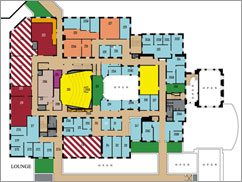  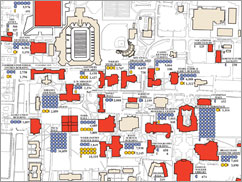 |
| A Utilization Analysis examines the effective use of existing space, such as classrooms, laboratories, or offices. A utilization study draws on the facility database to record and quantify existing use patterns. These analyses can lead to more efficient use patterns, potentially curtailing new construction. Alternatively, these analyses can clarify and justify the need for additional space. This data may be tested against a peer comparison or normative standards. Utilization analysis is fundamental to developing facility reuse strategies. |
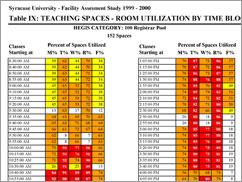  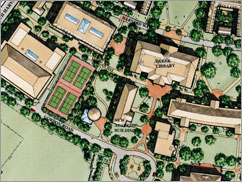 |
| A Peer Comparison examines the amount of space assigned for a particular use across a selection of similar institutions. Comparisons are often expressed as a ratio of floor area to numbers of people. This information helps assess the adequacy of space assignments. Preparation of a facility database is a prerequisite task. At either the institutional scale or at the building or department level, peer comparisons can be effective in identifying and substantiating the amounts of space requested or allocated. |
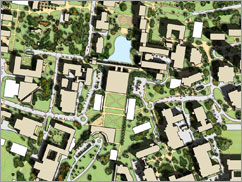   |
| Modeling provides guidelines for space allocation by projecting the amount of space departments would be assigned given consistent mission-driven assumptions. A set of standardized area (square foot) multipliers, appropriate to the space type and institution, determines the amount of space to provide for the number of people or the activity. A space allocation model can be used to quickly test what-if scenarios, helping an institution assess facility needs projections. Modeling is also readily linked to cost analysis. |
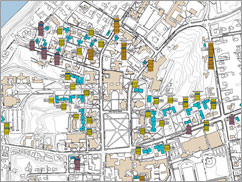   |
| Budget Assessment/Targeting is a process by which construction and project cost estimates are created for new construction or renovation associated with a concept plan alternative or facility program summary. Budget targeting uses the facility program summary as a basis for estimating the cost of construction to confirm a target budget for the project. If the amount of space in the facility program must be reduced, doing so early in the planning is most effective in maintaining the functionality and viability of the project. |
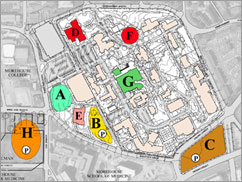   |
| A Facility Database records the inventory of spaces in a building being studied. A database is fundamental for a facility utilization analysis. In preparing a database, each assignable space is described with data fields that include: room number, room use, size, departmental designation, station count, and occupant. |
   |
| A Reuse Study identifies the best alternative for reuse of vacated space. Alternative reuses are tested to develop a strategy for space reallocation when a department relocates. Such an analysis may include preparation of concept plan alternatives. |
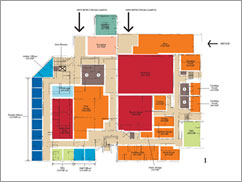   |
| Concept Plan Alternatives are prepared to clarify facility needs and requirements. Concept plans consist of scaled floor plans that articulate critical spatial relationships and establish feasibility and the magnitude of needed construction. Alternatives may involve new buildings, additions to existing buildings, or existing space reallocations. A concept plan is usually preceded by a facility utilization analysis and is often part of a broader reuse study. Alternatives can also provide the basis for a cost analysis. |
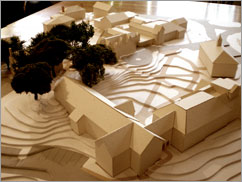  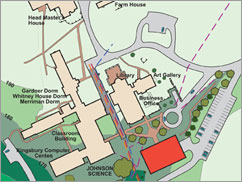 |
| Design Criteria are best developed during the early stages of planning for a new building, a building addition, or renovation of an existing building. Key design concepts and desirable characteristics that will enhance the effectiveness of the proposed facility changes are identified, defined, and clearly recorded to inform ensuing architectural design and construction. |
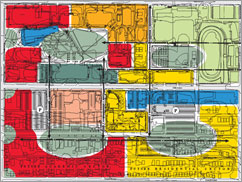   |
|
|














